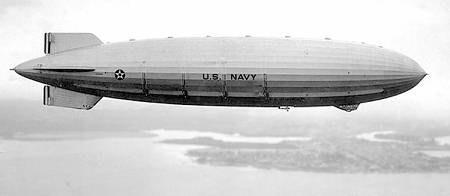Length: 785 ft (239.3 m)
Maximum Diameter: 132.32 ft (40.36 m)
Height: 152.32 ft (46.46 m)
Nominal Gas Volume: 6.5 million cu.ft (184,060 cu.m)
In November 1931, the airship flew to its home port, NAS Lakehurst, New Jersey. On May 3, 1932, Akron cruised above the coast of New Jersey and for the first time tested the "trapeze" installation for handling of aircraft while airborne; these tests consisted of historic "landings", first with a Consolidated N2Y trainer and then with the prototype Curtiss XF9C-1 "Sparrowhawk" fighter.
Akron departed NAS Lakehurst on May 18, 1932 and set out for the west coast of the United States. The airship proceeded down the eastern seaboard to Georgia and continued on over Texas and Arizona. En route to its base at Sunnyvale, California, it reached Camp Kearny, California located about 10 mls (16 km) north of downtown San Diego, on the morning of May 11, and attempted to moor to a mooring mast. Since neither the trained ground handlers nor the specialized mooring equipment needed by an airship of Akron's size were there, the landing at Camp Kearny was fraught with danger.
By the time it started the mooring attempt, the heat of the sun's rays had warmed the airship, and the engines had further lightened the airship by using 40 tons of fuel during the voyage across the continent. As a result, Akron became uncontrollable. The mooring cable cut to avert a catastrophic nose-stand by the errant airship, Akron headed up. Most men of the mooring crew, predominantly new seamen from the Naval Training Station at San Diego, let go their lines.
However, one man was carried 15 ft (4,6 m) into the air before he let go and suffered a broken arm in the process. Three others were carried up even farther. Two of these men lost their grips and fell to their deaths. The third clung desperately to his line and made himself fast to it before he was hoisted on board Akron one hour later. Nevertheless, Akron managed to moor at Camp Kearny later that day and later proceeded to Sunnyvale, California.
With Akron in need of repairs, the airship departed Sunnyvale on June 11, bound for NAS Lakehurst. The return trip was studded with difficulties—principally due to unfavorable weather. After a "long and sometimes harrowing" aerial voyage, it ultimately arrived at NAS Lakehurst on the 15th. That summer Akron entered a new phase of its career—one of intense experimentation with the revolutionary "trapeze" and a full complement of planes, Curtiss F9C-2 "Sparrowhawks". Although damaged in August 1932, Akron conducted eight flights over the Atlantic Ocean during the last three months of 1932. These operations involved intensive work with the trapeze and the F9Cs.
On January 3, 1933, Akron headed south, down the eastern seaboard an shaping a course toward Florida. It refueled at the Naval Reserve Aviation Base, Opa-Locka, Florida, near Miami, on January 4 and then proceeded to Guantanamo Bay, Cuba, for an inspection of base sites. At this time, it used one of its N2Y-1s as an aerial "taxi" to ferry members of the inspection party back and forth. On March 11, Akron departed NAS Lakehurst and headed for Panama. It stopped briefly en route at NRAB Opa-Locka before proceeding on to Balboa, Canal Zone and then returning to the USA.
On the evening of April 3, 1933, Akron cast off from its moorings a NAS Lakehurst to operate along the coast of New England, assisting in the calibration of radio direction finder stations. As it proceeded on its way, Akron encountered severe weather which did not improve as it passed over Barnegat Lighthouse, New Jersey, at 22.00 hours. Wind gusts of terrific force struck the airship unmercifully around 00.30 hours on April 4 and pushed it down toward the sea. It crashed tail first and then sank in the stormy Atlantic Ocean.
A German motorship in the vicinity, saw lights descending toward the ocean at about 00.23 hours and altered course to starboard to investigate, thinking it was witnessing a plane crash. At 00.55 hours Phoebus's men picked up Akron's unconscious executive officer and three enlisted men, one of whom was also unconscious; he never regained consciousness and died on board the ship. A total of 73 men died in the crash including Rear Admiral William A. Moffett, Chief of the Bureau of Aeronautics. Two other men died when the Navy non-rigid airship J-3, sent out to search for survivors, also crashed. This was the beginning of the end of rigid airships in the USN."
